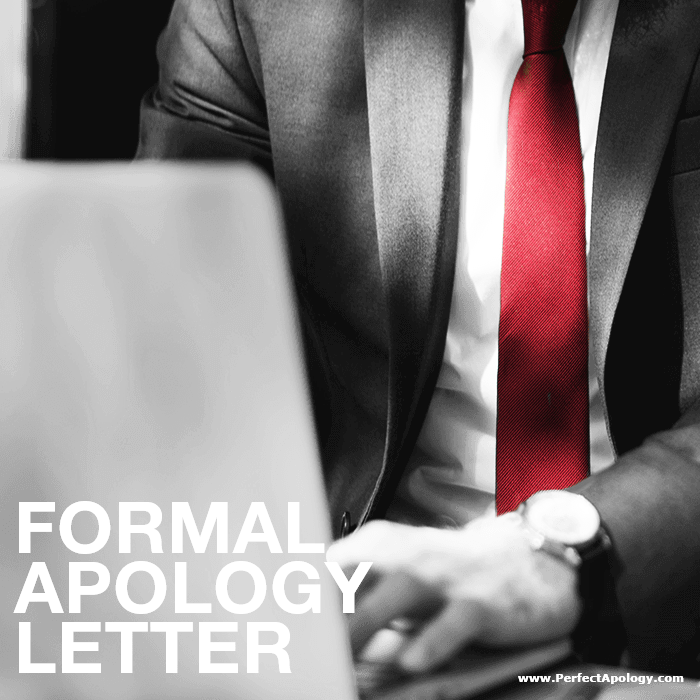Formal Apology Letter
A formal apology letter requires certain extra elements to underscore the sentiment, reinforce the message, convey to the recipient that you're taking the situation seriously, and that you are truly sorry.
The content or 'ingredients' for a formal apology remain the same as always, it's the format, language, and presentation of the letter that brings formality.
↓ Versión en español: Carta de disculpa formal / profesional

When dealing with apologies directed to other companies, a group, or to the community at large, a formal approach should always be taken.
How To Write A Formal Letter of Apology
Below you'll find our template. It includes notes & tips to guide you through the process of writing a formal letter.
↓ Versión en español: Carta de disculpa formal / profesional
| Notes | Formal Apology Letter Template |
|---|---|
Salutation |
Dear _______________, |
The 1st paragraph should begin with your apology along with a detailed account of the situation. |
Please accept my sincere apology for ___________________on/at ________. It was wrong of me to _________________, and I am truly sorry. Avoid using any contractions (didn't and it's, I'm etc.). "Did not" and "It is" are more suitable for formal apology letters. Avoid using any casual language, slang, or vague terms for the entire body of the letter. |
In the 2nd paragraph acknowledge the hurt, the harm caused, take full responsibility, without making excuses. |
I can appreciate how [hurt/angry] and [frustrated/disappointed] you are given the consequences of my actions and the trouble I have caused. |
In the 3rd, promise that it won't happen again, include a statement of regret, and provide some way of easing the pain caused or form of restitution if appropriate. |
Please be assured that I have taken all the necessary measures so that this type of mistake never happens again. |
End your letter by apologizing again and asking for forgiveness. |
Once again, I am truly sorry and humbly ask for your forgiveness. Sincerely yours, (or Respectfully yours,) |
| Notas | Plantilla de carta de disculpa formal |
|---|---|
Carta de disculpa formal / profesionalEsta carta de disculpa formal puede ser fácilmente modificada y adaptada a su situación. |
|
Saludos |
Querido (a) _______________, |
El primer párrafo debe comenzar con su disculpa junto con un relato detallado de la situación.
|
Por favor, acepte mis sinceras disculpas por ___________________sobre/en ________. Fue un error de mi parte _________________, y lo siento de verdad. Evita usar cualquier contracción (no lo hice y es, estoy etc.). "No lo hice" y "Es" son más adecuados para las cartas de disculpa formales. Evita usar cualquier lenguaje casual, jerga o términos vagos en todo el cuerpo de la carta. |
En el 2o párrafo reconozca el daño y el perjuicio causado, asuma toda la responsabilidad, sin poner excusas. |
Puedo apreciar lo [herido/enojado] y [frustrado/decepcionado] que te dan las consecuencias de mis acciones y los problemas que he causado. |
En el tercero, prometa que no volverá a suceder, incluya una declaración de arrepentimiento y proporcione alguna forma de aliviar el dolor causado o una forma de restitución si es apropiado. |
Le aseguro que he tomado todas las medidas necesarias para que este tipo de error no vuelva a ocurrir. |
Termine su carta disculpándose de nuevo y pidiendo perdón. |
Una vez más, lo siento mucho y humildemente pido su perdón. Sinceramente suyo, (o respetuosamente suyo,) |
This formal apology letter can easily be modified and tailored to your situation. Think of it as a template.
Use the notes and tips as a guide, fill in the blanks, and add your own details. Just remember to be professional, keep things clear and concise, and avoid any subjective language (words like awful or terrible etc.).
Formal Letter of Apology: How Formal To Go?
Whether it's through a public apology or an apology letter, (especially in business) the formality underscores the sentiment, reinforces the message, and conveys to the recipient that you're taking the situation seriously.
However, if the recipient of the apology is an individual then we need to examine the relationship we have with them prior to deciding on how formal an approach we should take.
Are they purely a business contact? A co-worker? Our boss? Do we have any sort of personal relationship with them? If so, how long has it been? Historically, have our exchanges been more formal or friendly? What kind of personality do they have?
These are exactly the types of questions you need to ask yourself before deciding on how formal the apology should be.
If a formal approach is warranted then take note of the following guidelines.
A formal letter should always be typed and written on quality paper. It should be concise and on point (especially when mistakes are made), be approximately three paragraphs in length and free of any typos or grammatical errors.
In terms of layout, a standard block business format should be used, which means that everything is justified left and single spaced except in between paragraphs.
For all formal letters, Times New Roman or another standard serif font should be used.
Common Sense and Formal Apologies
A rule of thumb to go by is the more distant the relationship the more formal the approach. A formal apology is also warranted whenever hierarchy is involved, for example, when apologizing to one's boss or to an employee.
The mere fact that the parties involved are not equals requires that the apology be formal for it to be seen as legitimate.
What if the employee or boss is also a friend?
Then a two-tiered approach can be taken. This will help to define the relationship as one of both business and friendship. So, a more formal letter of apology should be written to satisfy the business side while a follow-up conversation will help to re-establish the friendship.
Individual Personalities and A Formal Approach
Your personality and that of the recipient are other key considerations when it comes to the level of formality required. If you or they are formal by nature, then it only makes sense that your apology should reflect the same.
If the person is normally shy or reserved and doesn't enjoy confrontation, take that into account. This type of individual would more likely appreciate receiving a note or letter rather than a face-to-face apology.
Formal Public Apologies
Most often delivered by people in the public eye or those that represent public institutions a public apology will almost always be directed at multiple recipients.
Whenever a group is involved a formal approach should be taken regardless of whether the apology is delivered verbally or through an open letter. Here, more importantly than in any other situation, the formality underscores the seriousness of the incident and conveys an understanding of the implications and repercussions of the event.
Formal Letters & Apologies Depend On The Relationship
Understanding who you're apologizing to and knowing the kind of relationship you share will help determine the type of business apology required, how formal an apology it should be, as well as the manner in which to deliver it.


